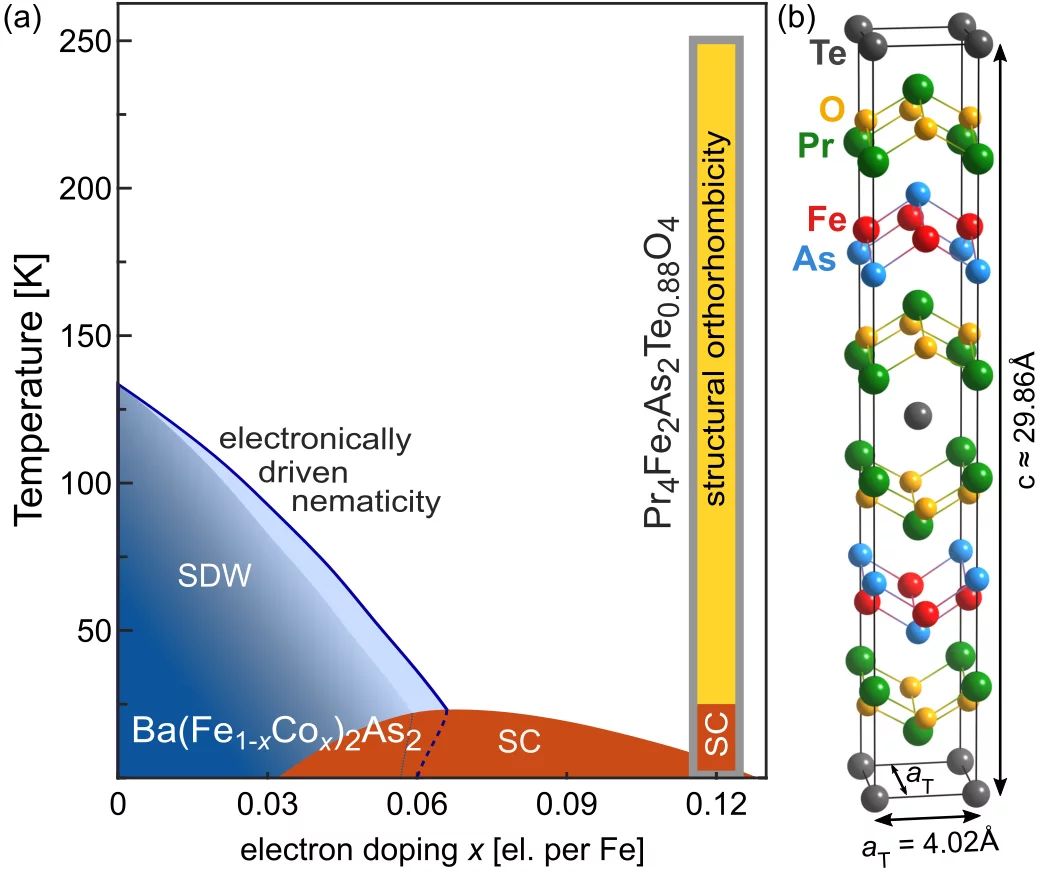Since the discovery of unconventional superconductivity in iron pnictides the study of their phase diagrams has been one of the key topics to reveal the superconducting pairing mechanism. So far, the nematic phase and its competition with superconductivity in crystals with low charge carrier density has been the focus of many studies. This phase is characterized by broken four-fold rotational symmetry in the crystal structure and in the electronic degrees of freedom. As the four-fold symmetry is broken simultaneously in the structural and electronic degrees of freedom it has not been possible to explore the effect of purely structural orthorhombicity on superconductivity. Now, a team of researchers at University of Zurich, EPFL, and PSI, together with researchers from Germany, China and the UK have discovered a new phase in the superconducting iron-pnictide Pr4Fe2As2Te0.88O4, which breaks four-fold symmetry only in the crystal structure but not in the electronic degrees of freedom. In contrast to the electronically driven nematicity, this structural orthorhombicity is found at surprisingly high electron doping and shows no signatures of phase competition with superconductivity.
One of the key challenges in this study was that the plate-like crystals, which were grown by collaborators at EPFL in Lausanne, were extremely small. The largest specimen measured only 50 um x 50 um, similar to the diameter of a human hair. Therefore, the researchers had to use state-of-the-art synchrotrons that provide a high-flux photon beam that is well focused on a small spot. This is provided only by a few facilities world-wide such as the Swiss Light Source SLS, the Diamond Light Source, and the German Electron Synchrotron DESY which were used for this study. For some of the experiments, the researchers had to come up with unconventional methods. For example, to lower background noise in the x-ray scattering experiments performed at DESY, they fixed the sample on the tip of a cactus needle.
The observation of this purely structural symmetry breaking with the exceptional high onset temperature of ~250 K is the first in the iron-pnictide compound family and is expected to initiate many follow up studies. For example, investigating the doping dependence of its transition temperature or its influence on magnetism could provide further insights into the exotic physics of this material family.
Contact
Dr. Christian Matt
Harvard University (formerly at University of Zürich)
E-mail: cmatt@g.harvard.edu
Prof. Johan Chang
University of Zürich
Telephone: +41 44 635 5748
E-mail: johan.chang@physik.uzh.ch
Original Publication
Decoupling of lattice and orbital degrees of freedom in an iron-pnictide superconductor
C. E. Matt, O. Ivashko, M. Horio, J. Choi, Q. Wang, D. Sutter, N. Dennler, M. H. Fischer, S. Katrych, L. Forro, J. Ma, B. Fu, B. Q. Lv, M. v. Zimmermann, T. K. Kim, N. C. Plumb, N. Xu, M. Shi, and J. Chang
Phys. Rev. Research 3, 023220 (2021)
DOI: https://doi.org/10.1103/PhysRevResearch.3.023220
